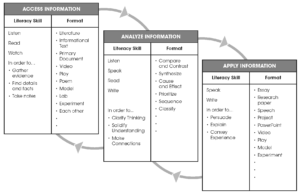Share this article.
The Common Core State Standards for English Language Arts and Literacy in History/Social Studies, Science, and Technical Subjects were developed out of the recognition of the value for consistent, real-world learning goals, and the need for all students, regardless of where they go to school, to be prepared for college, career, and life. They lay out a vision of what it means to be a successful and literate person in the 21st Century and issue a call to integrate literacy instruction.
“To be ready for college, workforce training, and life in a technological society, students need the ability to gather, comprehend, evaluate, synthesize, and report on information and ideas, to conduct original research in order to answer questions or solve problems, and to analyze and create a high volume and extensive range of print and nonprint texts in media forms old and new. The need to conduct research and to produce and consume media is embedded into every aspect of today’s curriculum. In like fashion, research and media skills and understandings are embedded throughout the Standards rather than treated in a separate section.” (National Governors Association Center for Best Practices & Council of Chief State School Officers, 2010)
And, these standards cannot be met unless:
- There is integration of the skills across the literacy and the content areas.
- Students are clear about what skill they are learning and how they will utilize it in their present and future learning.
- Students are aware of and can articulate their learning and thinking processes.
The most efficient and effective way to help your students do this is by utilizing the design of the standards to build an integrated scope and sequence, integrated literacy units of instruction, and integrated daily lessons. That’s why in this series of articles, we’ve provided the support to understand the embedded patterns in the standards and the tools to analyze those patterns including the learning progressions, the skills within the standards, and the literacy correlations.
Now in this article, you will learn exactly what is an integrated literacy unit and how to build one for your students.
Why Use Integrated Literacy Units?
The standards have set higher expectations for students to do more with texts. For conceptual clarity, their structure is based on the strands of literacy, but the authors make it clear that skills within the standards are closely connected and should be integrated in the classroom.
“Students can, without significant scaffolding, comprehend and evaluate complex texts across a range of types and disciplines, and they can construct effective arguments and convey intricate or multifaceted information. Likewise, students are able independently to discern a speaker’s key points, request clarification, and ask relevant questions. They build on others’ ideas, articulate their own ideas, and confirm they have been understood. Without prompting, they demonstrate command of standard English and acquire and use a wide-ranging vocabulary. More broadly, they become self-directed learners, effectively seeking out and using resources to assist them, including teachers, peers, and print and digital reference materials.” (National Governors Association Center for Best Practices & Council of Chief State School Officers, 2010)
 A logical outcome for students who meet the standards will be having the skills in reading, writing, speaking, and listening to be creative, purposeful, and successful in their expression of language. Therefore, it is incumbent on teachers to provide instruction that builds students’ receptive skills through reading and listening, their thinking skills through analyzing the information they are receiving, and their productive skills through writing and speaking about their thinking.
A logical outcome for students who meet the standards will be having the skills in reading, writing, speaking, and listening to be creative, purposeful, and successful in their expression of language. Therefore, it is incumbent on teachers to provide instruction that builds students’ receptive skills through reading and listening, their thinking skills through analyzing the information they are receiving, and their productive skills through writing and speaking about their thinking.
Simply put, teachers must integrate the standards into literacy units that support students in being able to:
- Access information by reading and researching a variety of sources.
- Analyze information by critiquing, clarifying, examining, and discussing it.
- Apply their new learning by communicating it to others through written and spoken language.
This is the framework for an integrated literacy unit. Let’s take a closer look at each piece.
How Students Access Information
Students access information by listening, reading, and watching in order to:
- Gather evidence
- Find details and facts
- Take notes
They do this with a variety of formats, such as literature, informational text, video, listening to each other, podcasts, etc. This stage of the integrated unit occurs early on and focuses on the standards that emphasize what it means to gather textual evidence. Teachers should begin building their units with the reading standards, the skills within the standards, and the texts from their adopted materials. Then they should identify the standards in other strands with the skills that correlate to gathering evidence.
How Students Analyze Information
Students analyze information by listening, speaking, reading, and writing in order to:
- Clarify thinking
- Solidify understanding
- Make connections
They do this with a variety of formats, such as compare and contrast, synthesize, prioritize, sequence, etc. This stage of the integrated unit occurs throughout the unit and focuses on the standards that emphasize what students should do with the information they have gathered. Students will move between the Analyze and Access stages as they gather and think about the information they need to apply their new learning about the information.
How Students Apply Their New Learning
Students apply their new learning by speaking and writing in order to:
- Persuade
- Explain
- Convey experience
They do this with a variety of formats, such as essay, research paper, speech, project, video, model, etc. This stage of the integrated unit occurs near the end of the unit and is undergirded by the writing standards. Students will move between the Apply and Analyze stages as they refine their thinking and produce their new learning through persuasion, explanation, or experience.
Integrated Literacy Develops Learnership
The Common Core State Standards for English Language Arts and Literacy in History/Social Studies, Science, and Technical Subjects not only provide end-of-year expectations, but they also provide the framework to meet those expectations through integrated units and lessons and to support conceptual redundancy of the skills within the standards through an integrated scope and sequence that leads to mastery. And, it is this integration that makes literacy instruction effective because it supports students to gather information, think critically about that information, and produce their thinking around the information. That’s why the apex of the Access—Analyze—Apply framework for an integrated unit is a product of a student’s thinking. As Timothy Shanahan says,
“Writing about text was more powerful than just reading it or reading it and rereading it/studying it/discussing it.”
But more importantly, the notion of integrated literacy is rooted in the concept of student ownership. Students who own their learning are able to articulate their thinking to the following questions for each and every literacy lesson:
- Why am I learning this?
- What am I learning?
- How am I learning this?
- How am I showing I am learning it?
- How am I using this learning later?
- What is my role in the learning?
Teachers who have students who own their learning are able to leverage the embedded patterns to answer these questions both in their planning and in their literacy instruction. These teachers are not only developing literate citizens for the 21st Century, they are developing students with learnership.
Continue the Learning
Check out these articles and resources to continue your learning about this topic…
The Learning Brief
In this article you learned…
- That to be college and career ready, students need to be able to gather, comprehend, evaluate, synthesize, and report on information and ideas, to conduct original research in order to answer questions or solve problems, and to analyze and create a high volume and extensive range of print and nonprint texts in media forms old and new.
- It is incumbent on teachers to provide instruction that builds students’ receptive skills through reading and listening, their thinking skills through analyzing the information they are receiving, and their productive skills through writing and speaking about their thinking.
- The standards design supports teachers to integrate the standards into literacy units so students can:
- Access information by reading and researching a variety of sources.
- Analyze information by critiquing, clarifying, examining, and discussing it.
- Apply their new learning by communicating it to others through written and spoken language.
Can you imagine building an environment full of motivated, engaged, and eager students who own their learning?
We can.


